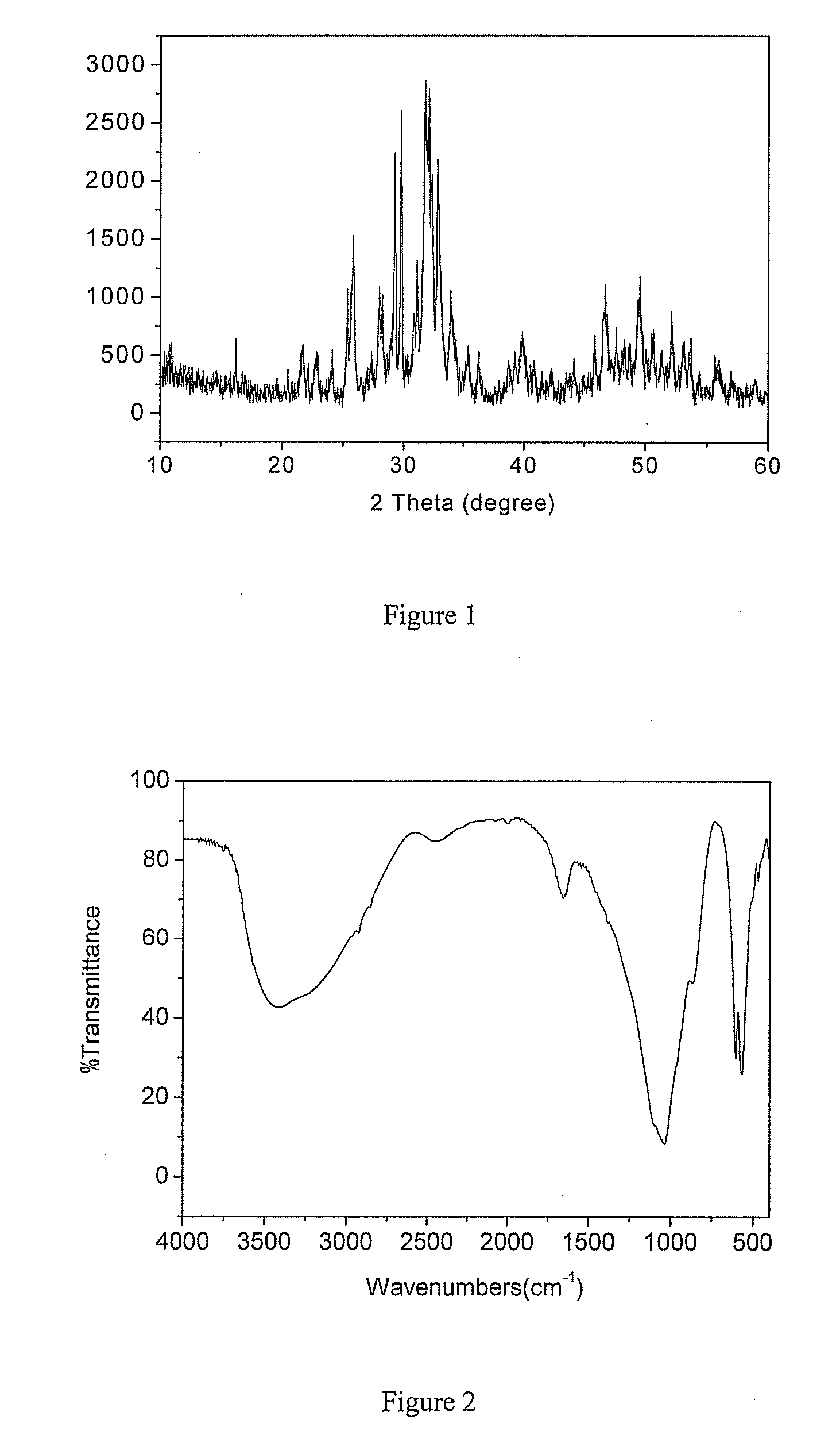Method for producing fluorapatite and its application
- Summary
- Abstract
- Description
- Claims
- Application Information
AI Technical Summary
Benefits of technology
Problems solved by technology
Method used
Image
Examples
example 1
[0033]Tetracalcium phosphate powder (2.66 g) and calcium hydrogen phosphate powder (1.36 g) were mixed evenly, then 0.4g sodium fluoride was added into and blent with the resultant mixed powder evenly in a mixing plate. After the powder mixture of the above three materials was added into 4 mL water, the obtained mixture was blent by a key to form a cement-like substance and further to form a gel-like substance. Fluorapatite was formed after the gel-like substance was kept in an environment with a temperature of 37° C. and a moisture of 100% for 3 days. The results of XRD, IR, and EDS, which characterize the chemical structure and composition of the product, are shown in FIG. 1-3. According to the XRD spectrum, the resultant product has characteristic peaks near 2θ=26 °, 2θ=32 °, 2θ=34 °, 2θ=40 °, 2θ=47 °, 2θ=50 °. This result indicates that the synthesized product is .fluorapatite. According to the IR spectrum, the absorption peaks for PO43−appear at 1070 cm−1 and 950 cm−1, and the ...
example 2
[0034]Tetracalcium phosphate powder (1.33 g) and calcium hydrogen phosphate powder (0.68 g) were mixed evenly, then 0.2 g sodium fluoride was added into and blent with the resultant mixed powder evenly in a mixing plate. After the powder mixture of the above three materials was added into 2 mL water, the obtained mixture was blent by a key to form a cement-like substance and further to form a gel-like substance. An experimental sample was acquired after a tooth was filled with the gel-like substance in the place where tooth enamel defects caused by caries appeared and kept in an environment with a temperature of 37° C. and a moisture of 100% for 3 days. As shown in FIG. 4, microcosmic structure of the material's surface was characterized by SEM. According to the SEM photo, fluorapatite was combined with tooth enamel closely without any obvious gap on their interface. This result also indicates that the repairing material fluorapatite has a similar composition with tooth enamel, so t...
example 3
[0035]Tetracalcium phosphate powder (26.6 g) and calcium hydrogen phosphate powder (13.6 g) were mixed evenly with a star-shape ball mill. Four gram of sodium fluoride was add into water to form its solution. After the powder mixture of tetracalcium phosphate and calcium hydrogen phosphate was added into 40 mL water, the obtained mixture was blent by a key to form a cement-like substance and further to form a gel-like substance. An experimental sample was acquired after a tooth was filled with the gel-like substance in the place where tooth enamel defects caused by caries appeared and kept in an environment with a temperature ranging from 35° C. to 38° C. and a moisture of 100% for 3 days.
[0036]Another embodiment disclosed in the present invention, characterized in mixing tetracalcium phosphate, ammonium fluoride, and a phosphoric acid / water solution, meets the following criteria:[0037]1. Molar ratio of tetracalcium phosphate to phosphoric acid is 5:2.[0038]2. Molar ratio of tetraca...
PUM
 Login to View More
Login to View More Abstract
Description
Claims
Application Information
 Login to View More
Login to View More - R&D
- Intellectual Property
- Life Sciences
- Materials
- Tech Scout
- Unparalleled Data Quality
- Higher Quality Content
- 60% Fewer Hallucinations
Browse by: Latest US Patents, China's latest patents, Technical Efficacy Thesaurus, Application Domain, Technology Topic, Popular Technical Reports.
© 2025 PatSnap. All rights reserved.Legal|Privacy policy|Modern Slavery Act Transparency Statement|Sitemap|About US| Contact US: help@patsnap.com



